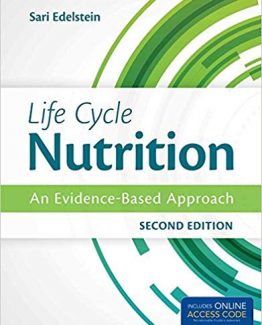Crisis Intervention Strategies 8th Edition by Richard K. James, ISBN-13: 978-1305271470
[PDF eBook eTextbook] – Available Instantly
- Publisher: Cengage Learning; 8th edition (February 8, 2016)
- Language: English
- 752 pages
- ISBN-10: 1305271475
- ISBN-13: 978-1305271470
This authoritative, best-selling text presents the latest skills and techniques for handling crisis situations. The authors’ task model clearly illustrates and elucidates the process of dealing with people in crisis, from defining the problem to obtaining commitment. Using this model, the authors build specific strategies for handling a myriad of different crisis situations, accompanied in many cases with the dialogue that a practitioner might use when working with the individual in crisis. This book puts you on the front lines with the crisis worker throughout the chapters, and then illuminates the techniques and strategies the worker used. Crisis intervention techniques, ensuring that you not only understand the theoretical underpinnings of crisis intervention theories, but also know how to apply them in crisis situations.
Table of Contents:
Cover Page
Title Page
Copyright Page
Dedication
Preface
Acknowledgments
Part 1. Basic Training: Crisis Intervention Theory and Application
Chapter 1. Approaching Crisis Intervention
A Brief History of Crisis Intervention
Grassroots Movements
The Importance of Volunteerism
The Need for Institutionalism
The Media and the Societal Impetus for Crisis Intervention
The Case against Too Much “Helping”
Definitions of Crisis
Individual Crisis Definitions
Behavioral Emergencies
Systemic Crisis Definitions
Metastasizing Crisis
Characteristics of Crisis
Transcrisis States
Transcrisis Differentiated from Posttraumatic Stress Disorder
Transcrisis Points
Theories of Crisis and Crisis Intervention
Basic Crisis Intervention Theory
Expanded Crisis Theory
Applied Crisis Theory
Crisis Intervention Models
The Equilibrium Model
The Cognitive Model
The Psychosocial Transition Model
The Developmental-Ecological Model
The Contextual-Ecological Model
Psychological First Aid
The ACT Model
Playbook/Game Plan Model
Eclectic/Integrated Crisis Intervention Theory
Characteristics of Effective Crisis Workers
Life Experiences
Personal Characteristics
Rewards
Summary
Chapter 2. Culturally Effective Helping in Crisis
Multicultural Perspectives in Crisis Intervention
Core Multicultural Attributes
Culturally Biased Assumptions
Universal versus Focused Views
Working on the Individualist/Collectivist–High/Low-Context Continuum
Emic versus Etic Models of Multiculturalism
Awareness of both Ecology and Multicultural Competencies
Shortcomings of a Multiculturalist Approach to Crisis Intervention
Culturally Effective Helping during a Crisis
Positive Aspects of an Effective Multicultural Counselor
When in Rome, Italy … or Georgia
Language Barriers
Religion and Spirituality
Support Systems
Occupation as a Cultural Barrier
Geographic Locale as a Cultural Barrier
The Dilemma of Local Consultation
The Necessity of Acting
Training
Where It Stands now … Sorta
Summary
Chapter 3. The Intervention and Assessment Models
Introduction
A Hybrid Model of Crisis Intervention
Task 1. Predispositioning/Engaging/Initiating Contact
Task 2. Problem Exploration: Defining the Crisis
Task 3. Providing Support
Default Task: Safety
Task 4. Examining Alternatives
Task 5. Planning in Order to Reestablish Control
Task 6. Obtaining Commitment
Task 7. Follow-Up
Assessment in Crisis Intervention
Assessing the Severity of Crisis
The ABCs of Assessing in Crisis Intervention
The Triage Assessment System
The Triage Assessment Form
Alternate Forms of the TAF
Psychobiological Assessment
Assessing the Client’s Current Emotional Functioning
Assessing Alternatives, Coping Mechanisms, and Support Systems
Assessing for Suicide/Homicide Potential
Summary
Chapter 4. The Tools of the Trade
Introduction
Listening in Crisis Intervention
Open-Ended Questions
Closed-Ended Questions
Restatement and Summary Clarification
Owning Feelings
Facilitative Listening
Basic Strategies of Crisis Intervention
Climate of Client Growth
Communicating Empathy
Communicating Genuineness
Communicating Acceptance
In the Field
Acting in Crisis Intervention
Directive Intervention
Collaborative Counseling
Nondirective Counseling
Action Strategies for Crisis Workers
Summary
Chapter 5. Crisis Case Handling
Handling Crisis Cases versus Long-Term Cases
Case Handling at Walk-In Crisis Facilities
Types of Presenting Crises
Case Handling at a Community Mental Health Clinic
Police and Crisis Intervention
Changing Role of the Police
Police and the Mentally Ill/Mentally Disturbed
The Crisis Intervention Team (CIT) Program
Transcrisis Handling in Long-Term Therapy
Anxiety Reactions
Regression
Problems of Termination
Crisis in the Therapy Session
Psychotic Breaks
People with Borderline Personality Disorder
Counseling Difficult Clients
Ground Rules for Counseling Difficult Clients
Confronting Difficult Clients
Confidentiality in Case Handling
Summary
Chapter 6. Telephone and Online Crisis Counseling
Introduction
Case Handling on Telephone Crisis Lines
Telephone Counseling Strategies
Making Psychological Contact
Defining the Problem
Ensuring Safety and Providing Support
Looking at Alternatives and Making Plans
Obtaining Commitment
Errors and Fallacies
Regular, Severely Disturbed, and Abusive Callers
Understanding the Regular Caller’s Agenda
Handling the Severely Disturbed Caller
Other Problem Callers
Handling the Problem Callers
Hotlines
The Internet’s Growing Role in Crisis Intervention
Behavioral Telehealth
The Appeal of Online Counseling
Problems of Online Counseling
Netiquette
Predispositioning
Texting
Virtual Reality
Need for Training
Legal, Ethical, and Moral Issues of Telephone and Internet Counseling
Does It Work?
Summary
Part 2. Handling Specific Crises: Going into the Trenches
Chapter 7. Posttraumatic Stress Disorder
Introduction
Background
Dynamics of PTSD
Diagnostic Categorization
Complex PTSD
Conflicting Diagnoses
The Question of Preexisting Psychopathology
Neurophysiological Responses
Affective-State-Dependent Retention
Children and Neuropathology
Incidence, Impact, and Trauma Type
Incidence
Residual Impact
Importance of Trauma Type
Vietnam: The Archetype
Intrusive-Repetitive Ideation
Denial/Numbing
Increased Nervous Symptom Arousal
Dissociation
Social Supports
Maladaptive Patterns Characteristic of PTSD
The Traumatic Wake of Iraq and Afghanistan
The Comprehensive Solider Fitness Program
Components of Treatment for Adults
Assessment
Phases of Recovery
Importance of Acceptance
Risks of Treatment
Multiphasic/Multimodal Treatment
Psychotropic Medication
Individual Intervention Stages
Emergency/Outcry
Extinguishing Intrusive Images
Numbing/Denial
Reflection and Transition
Integration
Group Treatment
Support Groups
The Life Adjustment Group
Family Treatment
Eye Movement Desensitization and Reprocessing (EMDR)
The Controversy over EMDR
EMDR Therapy
Children and PTSD
Diagnostic Criteria for Children
Support Systems
Types of Trauma
Etched Memories
Developmental Issues
Other Responses to Type I Trauma
Type II Traumas
Intervention Strategies
Therapy
Moving beyond the Trauma
Summary
Chapter 8. Crisis of Lethality
Background
The Scope of the Suicide Crisis
Suicide and the Moral Dilemma
The Dynamics of Suicide
Psychological Theories
Sociological Theory
Interpersonal Theory
Existential-Constructivist Framework
Other Explanations
Characteristics of People who Commit Suicide
Similarities between Suicide and Homicide
Analyzing Suicide/Homicide Notes/Videos
Myths about Suicide
Assessment
Suicide Clues
Assessment Instruments
Clinical Interview
Using the Triage Assessment Form in Addressing Lethality
Intervention Strategies
The Three I’s
Older Adults
Guidelines for Family, Friends, and Associates
The Psychological Autopsy
Postvention
Losing a Client to Suicide
Summary
Chapter 9. Sexual Assault
The Scope of the Problem
Underreporting
Defining Rape: The Unique Situation of Sexual Abuse/Rape Survivors
The Dynamics of Rape
Social/Cultural Factors
Personal and Psychological Factors
Myths about Rape
Date and Acquaintance Rape
Date Rape Risk
Preventing Date, Acquaintance, and Other Forms of Rape
Intervention Strategies for Rape and Battery: The Case of Melody
Immediate Aftermath
The following Three Months
Adult Survivors of Childhood Sexual Abuse
Psychological Trauma and Sequelae
False Memories
Intervention Strategies for Adult Survivors: The Case of Heather
Assessment
Treatment of Adults
Discovery and Admission
Grounding
Validation
Extinguishing Trauma
Prolonged Exposure/Cognitive Restructuring
Grief Resolution
Support Groups for Adult Survivors
Sexual Abuse in Childhood
Dynamics of Sexual Abuse in Childhood
Dynamics of Sexual Abuse in Families
Phases of Child Sexual Abuse
Intervention Strategies with Children
Assessment
Therapeutic Options
Need for Affirmation and Safety
Regaining a Sense of Control
Education
Assertiveness Training
Intervention Strategies for Child Sexual Abuse: The Case of Elizabeth
Disclosure
Immediate Aftermath
Prosecuting the Perpetrator
Interviewing the Child
Preparing the Child for Testimony
Aftermath
Counseling
Group Counseling
Boundary Issues
Group Support Work with Nonoffending Parents
Preventing Revictimization
Individual Counseling
Summary
Chapter 10. Partner Violence
Introduction
The Incidence of Partner Violence
Emerging Approaches to Partner Violence
Dynamics of Partner Violence
Psychosocial and Cultural Dynamics
Psychological Factors
Stressors
Myths about Battering
Profiling the Batterer
The Cycle of Violence
Realities for Abused Women
Intervention Strategies
Assessment
Components of Intervention
Shelters
Counseling Women at Shelters
Follow-Up
Intervention with Children
Courtship Violence
Stalking
Gay and Lesbian Violence
Prevalence of Violence
Complicating Factors
Crisis Intervention Involving Gay and Lesbian Violence
Treating Batterers
Intervention Models
Hybrid Models
Treatment Goals
Assessment
The Intake Interview
Motivation
A Typical 24-Session Domestic Violence Reduction Group
Program Success
Summary
Chapter 11. Family Crisis Intervention
Introduction
Definition of Family Crisis
Transcrisis
Research on Family Crisis
Medical Crises
Disaster Recovery
Family Crisis Models
Types of Crisis Families Encounter
Dynamics of Family Intervention
Case Vignette
Hybrid Model Applied to Families
Stages of Family Resolution of Crises
Cultural Issues
Summary
Chapter 12. Personal Loss: Bereavement and Grief
Introduction
Terms Critical to Understanding Loss
Dynamics of Bereavement
Cultural Dynamics
Sociocultural Mores
Spirituality and Religion
Conceptual Approaches to Bereavement
Stage/Phase Models
A Counterpoint to Traditional Models
Assessment Tools
Types of Loss
Death of a Spouse
Loss due to Caregiving
Death of a Child
Bereavement in Childhood
Bereavement in Adolescence
Bereavement in Elderly People
HIV/AIDS
Job Loss
Separation and Divorce
Death of a Pet
Complicated/Prolonged Grief, Bereavement, and Mourning Reaction
Intervention Strategies.
Being There for Grievers: A Worker Imperative
Fitting Technique to Style of Grief
Cognitive-Behavioral Approaches
Narrative Therapy
Attachment Theory and Therapy
Dealing with Loss
Sudden Death of a Spouse
Traumatic Death of a Child
Bereavement in Childhood
Separation and Divorce
Death of a Pet
Bereavement in Elderly People
Bereavement in an HIV-Infected Client
Complicated Grief: Death of a Mother
The Crisis Worker’s Own Grief
Is There Any Lemonade in All These Sour Lemons?
Summary
Chapter 13. Crises in Schools
The New-Millennium, Violence-Proof School Building
Conflicting Statistics
Violence and Youth
Gangs
Types of Gangs
Emergence of Suburban and Rural Gangs
Gang Intervention/Prevention Programs
Bullying
Cyberbullying
The Estranged Violent Juvenile Offender
A Comparison of Traits, Characteristics, and Behaviors of SVJOs and EVJOs
Case Study: Seung-Hui Cho
Screening the EVJO
Interviewing the Potential EVJO
Acting
School-Based Suicide Prevention and Intervention
Risk Factors/Predictors/Cues
Preadolescent Suicide
Child and Adolescent Cases of Suicidal Ideation
Postvention
Planning for a Crisis
The Crisis Response Planning Committee
The School Crisis Response Team (SCRT)
Implementing the Crisis Plan
Physical Requirements
Logistics
Responding to the Crisis
Bereavement in Schools
Group Work
Defining the Boundaries
Transcrisis Intervention with Individuals and Total School Systems
The Case of Josh
Epilogue
Summary
Part 3. On the Home Front: Crisis in the Human Services Workplace
Chapter 14. Violent Behavior in Institutions
Introduction
Precipitating Factors
Institutional Culpability
Universities and Their Counseling Centers
Denial
Staff Culpability
Legal Liability
Dynamics of Violence in Human Services Settings
Violence Potential Assessment Instruments
Structured Professional Judgment
Bases for Violence
Intervention Strategies
Security Planning
Threat Assessment Teams
Training
Record Keeping and Program Evaluation
Stages of Intervention
The Violent Geriatric Client
Mild Disorientation: The Case of Cliff
Distinguishing between Illusions and Hallucinations
Severe Disorientation: The Case of Grace
Follow-Up with Staff Victims
Summary
Chapter 15. Legal and Ethical Issues on Crisis of Trauma
Introduction
Ethical and Legal Interface with Crisis Intervention
Misconceptions regarding Ethical Decision Making
The Five Moral Principles of Ethical Decision Making
Limitations of Implementing EDMs in the Context of Crisis
Discernment and Heuristics
Case Studies
Mental Health Center
Commentary
Disaster Center: Potential Sexual Abuse
Commentary
Community College Suicide
Commentary
Crisis Hotline: Potential Elder Abuse
Commentary
Schools: A Potential Runaway
Commentary
Summary and Implications for Practice
Chapter 16. Human Services Workers in Crisis: Burnout, Vicarious Traumatization, and Compassion Fatigue
Helping Professionals: Prime Candidates
Dynamics of Burnout
Cornerstones of Burnout
Research on Burnout Dynamics
Myths that Engender Burnout
Symptoms of Burnout
Levels of Burnout
Stages of Burnout
Worker–Client Relationships
Countertransference
Secondary Traumatic Stress/Vicarious Traumatization/Compassion Fatigue
Compassion Satisfaction
The Culpability of Organizations
Self-Recognition of Burnout
Intervention Strategies
Assessment
Intervention through Training
Intervention with the Organization
Self-Care
Private Practitioners and Burnout
Intervention with the Individual: A Case Study
Epilogue: Cross-Cultural Comparisons
Summary
Part 4. No Man’s Land: Facing Disaster
Chapter 17. Disaster Response
A Brief History of Disaster Mental Health Provision
Where the World Is
International Terrorism and Human-Made Disasters
New Directions and New Visions
System Overview
Microsystem
Mesosystem
Exosystem
Macrosystem
Chronosystem
Defining Principles of a Crisis Intervention Ecosystem
National Crisis Response Teams
Vertically and Horizontally Integrated Local Emergency Management Systems
Mental Health Components of Local EMAs
What Happened with Katrina?
Psychological First Aid and Psychosocial Support as Applied to Disaster Survivors
When More than PFA Is Needed
The Current State of Affairs
The People of Disasters: Responders and Survivors
Crisis Workers at the Disaster
Thoughts of a Mental Health Worker on Katrina One Year Later
Lessons I Learned from Katrina
Case Study of the Benefield Family
Focus on the Worker
Debriefing Models
Debriefing Emergency Workers
Debriefing Crisis Workers
Final Thoughts
Summary
Chapter 18. Chemical Dependency: The Crisis of Addiction
Sociocultural Determinants of Substance Abuse
Alcohol: Number One Abused Substance
Models of Addiction
Definitions of Commonly Used Terms
The Dynamics of Addiction
Defense Mechanisms
Enabling and Codependency
Children in Alcoholic Families
Family Rules in Alcoholic Families
Adult Children of Alcoholics
Treatment Approaches
Alcoholics Anonymous (AA)
Cognitive-Behavioral Therapy (CBT)
Inpatient Treatment: The Minnesota Model
Outpatient Programs
Contingency Management (CM)
Community Reinforcement Approach (CRA)
Reinforcement-Based Treatment (RBT)
Screening, Brief Intervention, and Referral to Treatment Model
Telehealth and Internet Interventions
Drug Antagonists to Alcohol Use
Inpatient or Outpatient?
Contemporary Model
Multivariate Diagnosis
Matching Treatment to Client
Dual Diagnosis
Intervention Strategies
Motivation and Stages of Change
To Drink or Not to Drink
Assessment
Crisis Points in Chemical Dependency Treatment
Detoxification
Principles of Treatment
Treatment Techniques
Treatment Goals
Treatment Protocol
Individual Therapy
The Treatment Group
Learning Relationship Skills
Accepting Responsibility
Getting past Denial
Confrontation
Limit Testing
Treatment Secrets
Disrupting Irrational Mental Sets
Overcoming Environmental Cues that Lead to Drinking
Treating the Family
Aftercare and Relapse Prevention
Summary
References
Chapter 19. Crisis/Hostage Negotiation
Dynamics of Hostage Taking
Types of Hostage Takers
The Mentally Disturbed
Other Hostage Takers
Stages and Dynamics of a Hostage Situation
Cultural Factors in Crisis/Hostage Negotiation
Intervention Strategies
Persuading the Hostage Taker to Give Up
Negotiating in a Hostage Situation: The Case of James
The Crisis Worker as Consultant
If You Are Put in the Role of Negotiator
If You Are Held Hostage
Intervention after Release
Crisis Intervention with Hostage Survivors
Crisis Intervention with the Hostage Negotiator
Summary
References
What makes us different?
• Instant Download
• Always Competitive Pricing
• 100% Privacy
• FREE Sample Available
• 24-7 LIVE Customer Support






Reviews
There are no reviews yet.